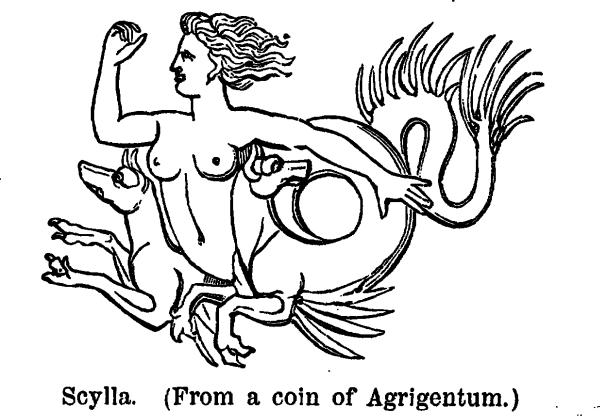 |
|||||||
|
|||||||
|
SCYLLA AND CHARYBDIS - Homer's Story in Ulysses
SCYLLA AND CHARYBDIS - Greek Mythos In Greek mythology, a sea monster who lived underneath a dangerous rock at one side of the Strait of Messia, opposite the whirlpool Charybdis. She threatened passing ships and in the Odyssey ate six of Odysseus' companions. SCYLLA AND CHARYBDIS - History & Reality Historically, Charybdis was a celebrated whirlpool in the Sicilian Straits, between Messana and Rhegium, but much nearer to the former. The prominent part which it assumes (together with the rock of Scylla on the opposite coast) in the Homeric narrative of the wanderings of Odysseus (Hom. Od. xii.) Sufficiently proves the alarm which it excited in the minds of the earliest navigators of these seas, and the exaggerated accounts of its dangers which they brought home. But with full allowance for such exaggeration, there can be no doubt that the tales of Charybdis and Scylla were really associated with the dangers that beset the navigation of the Sicilian Straits, and that in this instance the identification of the localities mentioned in the Odyssey may be safely relied on. Nor were these perils by any means imaginary: and in the case of Charybdis especially had more foundation than in regard to Scylla. Captain Smyth says of it:--To the undecked boats of the Greeks it must have been formidable: for even in the present day small craft are sometimes endangered by it, and I have seen several men-of-war, and even a seventy-four gun ship, whirled round on its surface: but by using due caution there is generally very little danger or inconvenience to be apprehended. It appears to be an agitated water, of from 70 to 90 fathoms in depth, circling in quick eddies. It is owing probably to the meeting of the harbour and lateral currents with the opposite point of Pezzo. (Smyth's Sicily, p. 123.) |
|||||||
| a celebrated whirlpool in the Sicilian Straits, between Messana and Rhegium, but much nearer to the former. The prominent part which it assumes (together with the rock of Scylla on the opposite coast) in the Homeric narrative of the wanderings of Odysseus (Hom. Od. xii.) Sufficiently proves the alarm which it excited in the minds of the earliest navigators of these seas, and the exaggerated accounts of its dangers which they brought home. But with full allowance for such exaggeration, there can be no doubt that the tales of Charybdis and Scylla were really associated with the dangers that beset the navigation of the Sicilian Straits, and that in this instance the identification of the localities mentioned in the Odyssey may be safely relied on. Nor were these perils by any means imaginary: and in the case of Charybdis especially had more foundation than in regard to Scylla. Captain Smyth says of it:--To the undecked boats of the Greeks it must have been formidable: for even in the present day small craft are sometimes endangered by it, and I have seen several men-of-war, and even a seventy-four gun ship, whirled round on its surface: but by using due caution there is generally very little danger or inconvenience to be apprehended. It appears to be an agitated water, of from 70 to 90 fathoms in depth, circling in quick eddies. It is owing probably to the meeting of the harbour and lateral currents with the opposite point of Pezzo. (Smyth's Sicily, p. 123.) |
|||||||